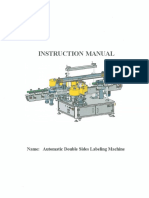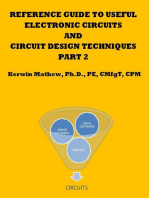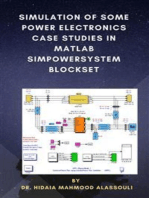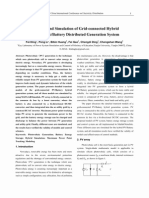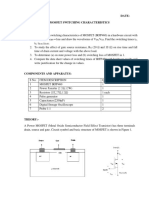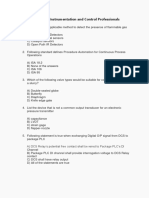0 ratings0% found this document useful (0 votes)
403 viewsBoost Converter-Result and Conclusion
The simulation of a converter in Matlab-Simulink showed excellent performance. The simulation results verified the theoretical analysis. The converter provides large output voltages and includes regulation to control the output voltage as the input voltage varies with irradiance levels in the photovoltaic array. This converter plays an important role in integrating renewable energy sources into the power grid by increasing the voltage.
Uploaded by
abcdefgCopyright
© © All Rights Reserved
Available Formats
Download as DOCX, PDF, TXT or read online on Scribd
0 ratings0% found this document useful (0 votes)
403 viewsBoost Converter-Result and Conclusion
The simulation of a converter in Matlab-Simulink showed excellent performance. The simulation results verified the theoretical analysis. The converter provides large output voltages and includes regulation to control the output voltage as the input voltage varies with irradiance levels in the photovoltaic array. This converter plays an important role in integrating renewable energy sources into the power grid by increasing the voltage.
Uploaded by
abcdefgCopyright
© © All Rights Reserved
Available Formats
Download as DOCX, PDF, TXT or read online on Scribd
You are on page 1/ 2
Result:
The simulation of the whole system has been done in Matlab-
Simulink and it shows an excellent performance of the
converter.
The simulation waveform verifies the theoretical analysis.
According to the specification the convertor provides large
over voltages, they will always include some regulation to
control the output voltage for varying the input voltage, with
respect to the irradiance in the PVarray. This converter plays
a very important role in the integration of renewable energy
sources into the grid for the boosting up the voltage.
Conclusion:
The Simulink platform proposed in this report must enable the
simulation of the Boost converter with the PV array. There are
many I.Cs. manufactured for this purpose, a typical example
of an I.C. for boost converter is the LM27313 from Texas
Instruments. This chip is designed for use in low power
systems such as PDAs, cameras, mobile phones, and GPS
devices.
The configuration of a portable PV power system that
produced maximum power under rapidly changing partial
shading conditions such as would be encountered in portable
applications. Under complex irradiance conditions, the power
generating capability is proposed. PV system was
approximately twice that of a conventionally configured series
system. The developed approach is broadly applicable, but is
perhaps most valuable in PV systems having high single-cell
voltages where direct input to a high-efficiency converter is
most practical.
You might also like
- Design and Simulation of 100mw Photovoltaic Power Plant Using Matlab SimulinkNo ratings yetDesign and Simulation of 100mw Photovoltaic Power Plant Using Matlab Simulink5 pages
- Practical Guides to Testing and Commissioning of Mechanical, Electrical and Plumbing (Mep) InstallationsFrom EverandPractical Guides to Testing and Commissioning of Mechanical, Electrical and Plumbing (Mep) Installations4/5 (4)
- Investigation of the Usefulness of the PowerWorld Simulator Program: Developed by "Glover, Overbye & Sarma" in the Solution of Power System ProblemsFrom EverandInvestigation of the Usefulness of the PowerWorld Simulator Program: Developed by "Glover, Overbye & Sarma" in the Solution of Power System ProblemsNo ratings yet
- Simulation of Some Power System, Control System and Power Electronics Case Studies Using Matlab and PowerWorld SimulatorFrom EverandSimulation of Some Power System, Control System and Power Electronics Case Studies Using Matlab and PowerWorld SimulatorNo ratings yet
- Methods for Increasing the Quality and Reliability of Power System Using FACTS DevicesFrom EverandMethods for Increasing the Quality and Reliability of Power System Using FACTS DevicesNo ratings yet
- STEM: Science, Technology, Engineering and Maths Principles Teachers Pack V10From EverandSTEM: Science, Technology, Engineering and Maths Principles Teachers Pack V10No ratings yet
- Reference Guide To Useful Electronic Circuits And Circuit Design Techniques - Part 1From EverandReference Guide To Useful Electronic Circuits And Circuit Design Techniques - Part 12.5/5 (3)
- Reference Guide To Useful Electronic Circuits And Circuit Design Techniques - Part 2From EverandReference Guide To Useful Electronic Circuits And Circuit Design Techniques - Part 2No ratings yet
- Power Systems-On-Chip: Practical Aspects of DesignFrom EverandPower Systems-On-Chip: Practical Aspects of DesignBruno AllardNo ratings yet
- A Matlab/Simulink-Based Photovoltaic Array Model Employing Simpowersystems ToolboxNo ratings yetA Matlab/Simulink-Based Photovoltaic Array Model Employing Simpowersystems Toolbox11 pages
- Simulation of Some Power Electronics Case Studies in Matlab Simpowersystem BlocksetFrom EverandSimulation of Some Power Electronics Case Studies in Matlab Simpowersystem BlocksetNo ratings yet
- Simulation of Some Power Electronics Case Studies in Matlab Simpowersystem BlocksetFrom EverandSimulation of Some Power Electronics Case Studies in Matlab Simpowersystem Blockset2/5 (1)
- A Case Study for a Single-Phase Inverter Photovoltaic System of a Three-Bedroom Apartment Located in Alexandria, Egypt: building industry, #0From EverandA Case Study for a Single-Phase Inverter Photovoltaic System of a Three-Bedroom Apartment Located in Alexandria, Egypt: building industry, #0No ratings yet
- Some Power Electronics Case Studies Using Matlab Simpowersystem BlocksetFrom EverandSome Power Electronics Case Studies Using Matlab Simpowersystem BlocksetNo ratings yet
- Design and Simulation of Transformer Less Single Phase Photovoltaic Inverter Without Battery For Domestic ApplicationNo ratings yetDesign and Simulation of Transformer Less Single Phase Photovoltaic Inverter Without Battery For Domestic Application6 pages
- OFF BOARD EV BATTERY CHARGER USING PV ARRAY- 23-10-24-2No ratings yetOFF BOARD EV BATTERY CHARGER USING PV ARRAY- 23-10-24-235 pages
- Design and Simulation of A PV System With Battery Storage Using Bidirectional DC DC Converter Using Matlab SimulinkNo ratings yetDesign and Simulation of A PV System With Battery Storage Using Bidirectional DC DC Converter Using Matlab Simulink9 pages
- Ijesrt: Modelling and Simulation of Solar Photovoltaic Array For Battery Charging Application Using Matlab-SimulinkNo ratings yetIjesrt: Modelling and Simulation of Solar Photovoltaic Array For Battery Charging Application Using Matlab-Simulink5 pages
- VSC-FACTS-HVDC: Analysis, Modelling and Simulation in Power GridsFrom EverandVSC-FACTS-HVDC: Analysis, Modelling and Simulation in Power GridsNo ratings yet
- Static-Inverter 1.0: A Complete Design Process to Convert D.C. to A.C. Electricity Using the Astable-MultivibratorFrom EverandStatic-Inverter 1.0: A Complete Design Process to Convert D.C. to A.C. Electricity Using the Astable-MultivibratorNo ratings yet
- Stem: Science, Technology, Engineering and Maths Principles V11From EverandStem: Science, Technology, Engineering and Maths Principles V11No ratings yet
- Stem: Science, Technology, Engineering and Maths Principles Teachers Pack V11From EverandStem: Science, Technology, Engineering and Maths Principles Teachers Pack V11No ratings yet
- Performance Evaluation of On-Grid and Off-Grid Solar Photovoltaic SystemsNo ratings yetPerformance Evaluation of On-Grid and Off-Grid Solar Photovoltaic Systems5 pages
- A Step by Step Technique For Using SimulNo ratings yetA Step by Step Technique For Using Simul10 pages
- Design of Standalone PV Charging System For LeadNo ratings yetDesign of Standalone PV Charging System For Lead6 pages
- Control of Hybrid Battery/Ultra-capacitor Energy Storage For Stand-Alone Photovoltaic SystemNo ratings yetControl of Hybrid Battery/Ultra-capacitor Energy Storage For Stand-Alone Photovoltaic System6 pages
- Power Measurements Under Nonsinusoidal Conditions : A Thesis in Electrical EngineeringFrom EverandPower Measurements Under Nonsinusoidal Conditions : A Thesis in Electrical EngineeringNo ratings yet
- Integration of Green and Renewable Energy in Electric Power SystemsFrom EverandIntegration of Green and Renewable Energy in Electric Power SystemsNo ratings yet
- An Isolated Solar Power Generation Using Boost Converter and Boost InverterNo ratings yetAn Isolated Solar Power Generation Using Boost Converter and Boost Inverter10 pages
- Modeling and Simulation of Grid-Connected Hybrid Photovoltaic/Battery Distributed Generation SystemNo ratings yetModeling and Simulation of Grid-Connected Hybrid Photovoltaic/Battery Distributed Generation System10 pages
- PV-Wind Turbine Hybrid Power System Simulation Using MATLAB/SimulinkNo ratings yetPV-Wind Turbine Hybrid Power System Simulation Using MATLAB/Simulink16 pages
- Advanced Control of AC / DC Power Networks: System of Systems Approach Based on Spatio-temporal ScalesFrom EverandAdvanced Control of AC / DC Power Networks: System of Systems Approach Based on Spatio-temporal ScalesNo ratings yet
- Design & Simulation of Solar DC Pump in Simulink: P.Badari Narayana B.R. Sanjeeva ReddyNo ratings yetDesign & Simulation of Solar DC Pump in Simulink: P.Badari Narayana B.R. Sanjeeva Reddy3 pages
- 2023 ARTICLE, PV System With Battery Storage Using Bidirectional DC-DC ConverterNo ratings yet2023 ARTICLE, PV System With Battery Storage Using Bidirectional DC-DC Converter11 pages
- EE8712 - Renewable Energy Systems Lab - Sample QuestionsNo ratings yetEE8712 - Renewable Energy Systems Lab - Sample Questions1 page
- Modeling and Simulation of Grid Connected PV System100% (2)Modeling and Simulation of Grid Connected PV System86 pages
- Low-voltage DC-DC off-grid PV system: various irradiance studiesNo ratings yetLow-voltage DC-DC off-grid PV system: various irradiance studies9 pages
- 3. Analysis and Design of Passive Filters for Power Quality Improvement in Standalone PV Systems (1)No ratings yet3. Analysis and Design of Passive Filters for Power Quality Improvement in Standalone PV Systems (1)6 pages
- 15ECE202 Digital Circuits and Systems: Answer All QuestionsNo ratings yet15ECE202 Digital Circuits and Systems: Answer All Questions2 pages
- 2.simulation of Single Phase Full Bridge Converter Using LTspice0% (1)2.simulation of Single Phase Full Bridge Converter Using LTspice10 pages
- Academic Year: 2017-18 Semester: Sixth Department: EEE Programme: B.Tech. EEE Course Code: 15EEE313 Course Title: Power ElectronicsNo ratings yetAcademic Year: 2017-18 Semester: Sixth Department: EEE Programme: B.Tech. EEE Course Code: 15EEE313 Course Title: Power Electronics10 pages
- Material and Equipment Standard: IPS-M-EL-161No ratings yetMaterial and Equipment Standard: IPS-M-EL-16119 pages
- Mk27 and Mk28 Extended Cargo: Medium Tactical Vehicle Replacement67% (3)Mk27 and Mk28 Extended Cargo: Medium Tactical Vehicle Replacement2 pages
- Leea. Uger: Dec. 19, 1967 D. F. Roxburgh Etal 3,358,561No ratings yetLeea. Uger: Dec. 19, 1967 D. F. Roxburgh Etal 3,358,56134 pages
- Engine Service Specifications: © 1998-2009 American Honda Motor Co., Inc. - All Rights Reserved AHM0% (1)Engine Service Specifications: © 1998-2009 American Honda Motor Co., Inc. - All Rights Reserved AHM42 pages
- Quiz Questions For Instrumentation and Control ProfessionalsNo ratings yetQuiz Questions For Instrumentation and Control Professionals5 pages
- Spec - Canter 6.5 Doble Cabina FEB71EL4WNQCNo ratings yetSpec - Canter 6.5 Doble Cabina FEB71EL4WNQC7 pages
- Parts of A Computer With Their FunctionsNo ratings yetParts of A Computer With Their Functions19 pages
- PowerFlex® 7000 Medium Voltage AC DriveNo ratings yetPowerFlex® 7000 Medium Voltage AC Drive350 pages
- MegaSquirt-I Programmable EFI System PCB2.2 - Kit W - BLACK CASE DIYAutoTuneNo ratings yetMegaSquirt-I Programmable EFI System PCB2.2 - Kit W - BLACK CASE DIYAutoTune2 pages



